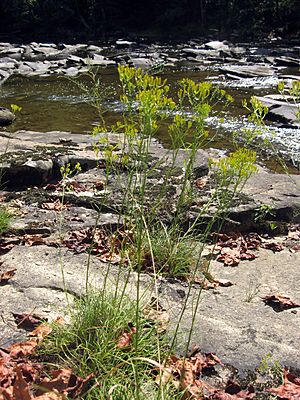Bigelowia facts for kids
Quick facts for kids Bigelowia |
|
|---|---|
 |
|
| Bigelowia nuttallii Found near the Black Warrior River in Blount County, Alabama. |
|
| Scientific classification |
|
| Kingdom: | Plantae |
| Clade: | Tracheophytes |
| Clade: | Angiosperms |
| Clade: | Eudicots |
| Clade: | Asterids |
| Order: | Asterales |
| Family: | Asteraceae |
| Tribe: | Astereae |
| Genus: | Bigelowia DC. 1836 |
| Synonyms | |
|
|
Bigelowia is a group of flowering plants found in North America. These plants belong to the daisy family, which is a very large group of plants. You can find them growing naturally in the United States.
Bigelowia plants are like small bushes, often growing together in clumps. They have many tiny yellow flowers that form small flower heads. These flower heads have disc florets (the small tube-shaped flowers in the center) but no ray florets (the petal-like flowers you see on the outside of a daisy).
Contents
What Are Bigelowia Plants Like?
Bigelowia plants are known as "subshrubs." This means they are woody at the base, like a small bush, but softer and more herbaceous (like a regular plant) towards the top. They often grow close together, forming a cluster or "clump" of plants.
Their flowers are quite small but appear in large numbers. Each tiny flower head is yellow. If you look closely, you'll see that these flower heads are made up of many small, tube-shaped flowers called disc florets. Unlike some other daisy family members, Bigelowia plants do not have the flat, petal-like flowers called ray florets.
Where Do Bigelowia Plants Grow?
These plants are native to the United States. This means they naturally grow there and are not brought in from other places. They are found in several states across the southeastern U.S.
Types of Bigelowia
Currently, there are two main types, or species, of Bigelowia plants that scientists recognize:
- Bigelowia nudata
- This species grows in states like Louisiana, Alabama, Mississippi, Georgia, Florida, South Carolina, and North Carolina.
See also
 In Spanish: Bigelowia para niños
In Spanish: Bigelowia para niños

